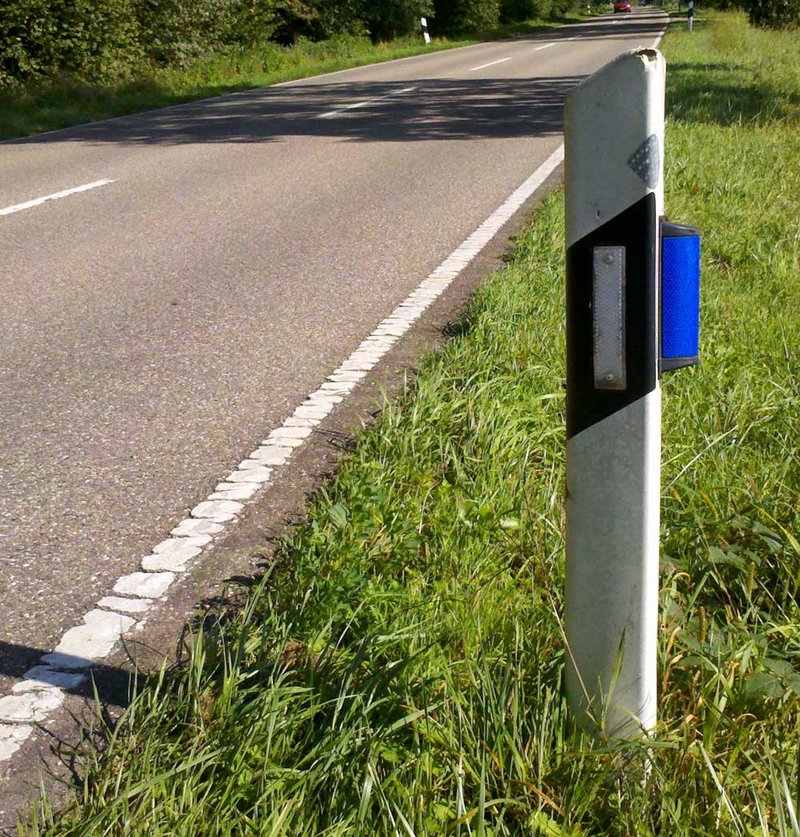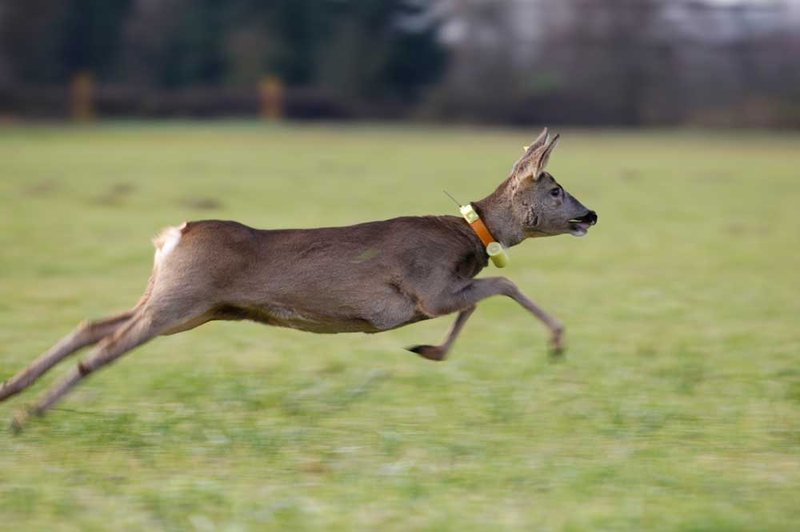
Fig. 1: Blue semicircle reflector
Every year, 260,000 wild animals are killed in road accidents. Eight-five percent of those animals are roe deer. In Germany, one accident involving wildlife happens every two minutes. However, the number of cases is assumed to be much higher because many accidents are not reported. Nationwide, reported wildlife-road accidents cause damage amounting to more than 650 million euros, which are covered by German insurance companies.
Research project effectiveness of wildlife warning reflectors
Wildlife warning reflectors are the most commonly used prevention measures against road kill. Over the last several decades, a multitude of reflectors have become available that, according to manufacturers, reduce road accidents with wildlife. Blue wildlife warning reflectors (fig. 1) are meant to prevent accidents especially due to their color. The evaluation of the effectiveness of wildlife warning reflectors has been assessed nearly entirely by the change in numbers of road kills. Studies that analyze behavioral reactions of wild animals have not been done in Germany. The question of whether installing wildlife warning reflectors influence the behavior of wild animals in the proximity of streets or when crossing roads was studied in a five-year research project of the Forstliche Versuchs- und Forschungsanstalt (FVA) Baden-Württemberg.
The project focused on the following questions:
- Is the color blue effective as a warning color as claimed by manufacturers?
- Does the light stimulus of the blue semicircle reflectors minimize behavior of wildlife that leads to accidents?
The color blue – a warning color?

Fig 2: Structurally modified feeding station with three feed bowls. In this arrangement, the left feed bowl is unlit, the bowl in the middle is illuminated with blue light and the right bowl lit with warm white light.
As part of a cooperative project with the Leibniz Institute for Zoo and Wildlife Research (IZW) in Berlin, blue and warm white lights were analyzed to determine whether they influence behavior of roe deer and if the color blue actually is a "warning color". The investigation was designed as an experimental feeding study in which the behavior of 15 captive deer was observed. For this purpose, feed bowls were illuminated in a randomly chosen order with blue and warm white light, and one feed bowl served as control and remained always unlighted (fig. 2). The animals were able to freely choose between the feed bowls. Their behavior was monitored with infrared cameras. The statistical results showed that the animals chose the blue-lit bowl 37% of the time followed by the white-lit bowl (34%). The unlit bowl was chosen 29% of the time. When the length of the feeding period was considered, it became clear that the animals fed on the blue and white-lit bowl on average about 10 seconds shorter than on the unlit feed bowl. These results indicate that light had a significant impact on the animals, but the manufacturers' claim that the blue color is a "warning color" could not be confirmed.
Reflector affects roe deer behavior?

Fig. 3: A vehicle passes a deer standing on the roadside.
The question of whether roe deer change their behavior in the presence of blue semicircle reflectors was investigated in road traffic situations at five street sections in Baden-Württemberg and under controlled conditions (enclosure) in cooperation with IZW.
To analyze the behavior at the different street sections, thermal heat cameras were used that recorded 16,000 hours of video, which showed there was 1,062 times that a situation involved roe deer and vehicles (fig. 3). It turned out that the proximity of the roe deer to the street is decisive for how strongly the animal reacted to approaching vehicles. Animals next to the road reacted most commonly through security or fleeing behavior. The further they were from the street the less common was this kind of reaction. Moreover, recorded video showed that the kind of behavior depends on the type of approaching vehicle and that the animals react more strongly to buses and trucks. The blue semicircle reflectors did not change the behavior of the animals in a way such that fleeing and security behavior was increased when there were approaching vehicles. The reflectors had no effect on the behavior of the animals. The reactions of roe deer to blue semicircle reflectors were also tested in an enclosure under controlled conditions on 33 animals. Both male and female animals showed the same unaltered behavior as the roe deer studied at the road sections. Thus, the results of the field experiment were confirmed.
Individual differences in road crossing behavior
In addition, the behavior of 46 deer was observed and documented over several years with the aid of GPS telemetry transmitters (fig. 4). The investigation centered on whether spatial or temporal changes in road crossing behavior occurred after installing blue semicircle reflectors. Thirty-two deer eventually crossed roads and they made 13,689 crossings, which were analyzed (fig. 5). It turned out that the animals had large individual differences in behavior. The frequency of road crossings was determined by the recorded movement activity of the individual animal: active animals crossed the road more often than inactive animals. Additionally, the activity of the animals was subject to diurnal as well as seasonal fluctuations. At twilight and at night, as well as in spring and autumn, animals were more active. Also, in this investigation, the blue semicircle reflectors did not influence the behavior of the roe deer. There was no change in frequency of road crossings in the different observed areas or where there were shifts of attempts of crossings from twilight and night to daytime hours. Also, the number of approaching vehicles had no effect on crossing behavior.

Fig. 4: GPS-collared roe deer "Nicola". (Photo: Klaus Echle)

Abb. 5: Number of road crossings of all deer with transmitters in the course of the day and the year (blue dots). Yellow lines represent sunrise and sunset, yellow diamonds indicate the death of a deer with a transmitter. Red symbolizes the intensity of the road traffic. The darker the red, the higher the number of vehicles.
Conclusion
Determining the effectiveness of wildlife warning reflectors based on changed wildlife accident numbers is critical because of many influencing factors. The deterring effect of the reflectors cannot be clearly shown. An analysis of 43 studies regarding wildlife warning reflectors published in the last 40-years showed that reflectors did not significantly reduce wildlife casualties[1]. However, a definitive statement allows for only the analysis of the behavior of wild animals. Looking directly at the roe deer behavior, it becomes clear that blue semicircle reflectors do not cause changes neither regarding behavioral alteration of deer at the roadside in the presence of traffic nor in the long term concerning the frequency of road crossings in GPS-collared roe deer[2,3]. In enclosures under controlled conditions roe deer exhibited the same behavioural patterns compared to deer close to roads[2]. These results confirmed those of the field experiment. In addition, feeding experiments did show that blue is not a "warning color" for deer[4]. In summary, this extensive behavioral study demonstrates that wildlife warning reflectors are not a suitable preventive measure for reducing vehicle-wildlife accidents.
Literature
- [1]Falko Brieger, Robert Hagen, Daniela Vetter, Carsten F. Dormann, Ilse Storch (2016): Effectiveness of light-reflecting devices: A systematic reanalysis of animal-vehicle collision data. Accident Analysis and Prevention 97, 242-260
- [2]Falko Brieger, Robert Hagen, Max Kröschel, Florian Hartig, Imke Petersen, Sylvia Ortmann, Rudi Suchant: Do roe deer react to wildlife warning reflectors? A test combining a controlled experiment with field observations. European Journal of Wildlife Research (2017) 63:72. DOI 10.1007/s10344-017-1130-5
- [3]Jim-Lino Kämmerle, Falko Brieger, Max Kröschel, Robert Hagen, Ilse Storch, Rudi Suchant (2017): Temporal patterns in road crossing behaviour in roe deer at sites with wildlife warning reflectors PLoS ONE 12(9): e0184761.
- [4]Falko Brieger, Jim-Lino Kämmerle, Nadja Martschuk, Sylvia Ortmann, Robert Hagen (2017): No evidence for a ‘warning effect’ of blue light in roe deer. Wildlife Biology: wlb.0033.
